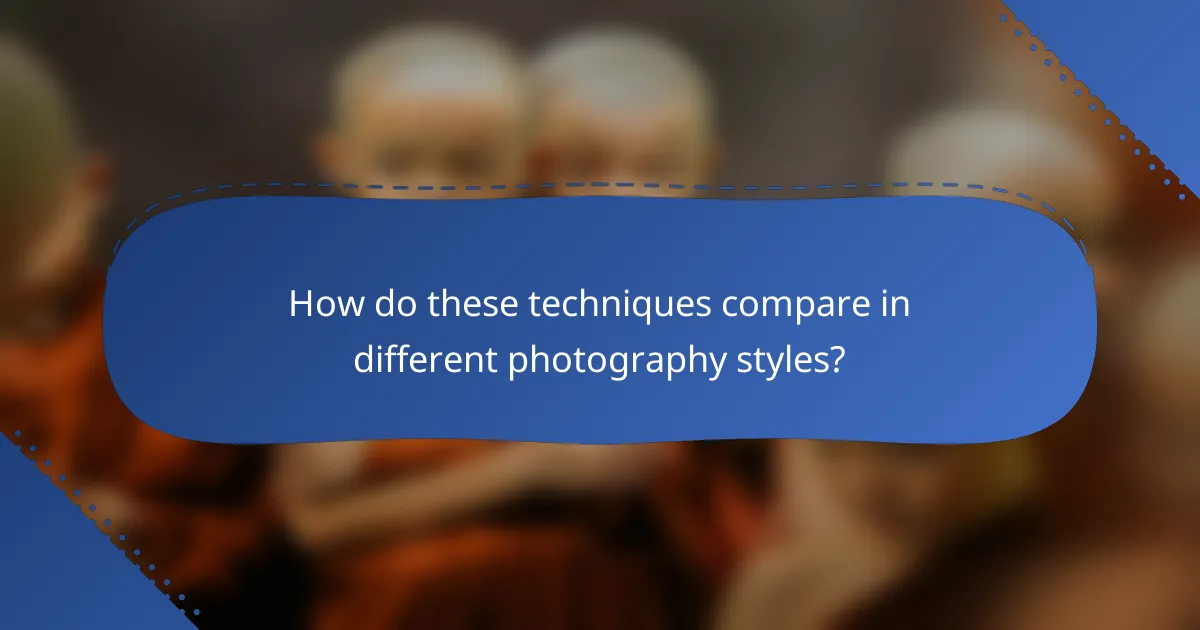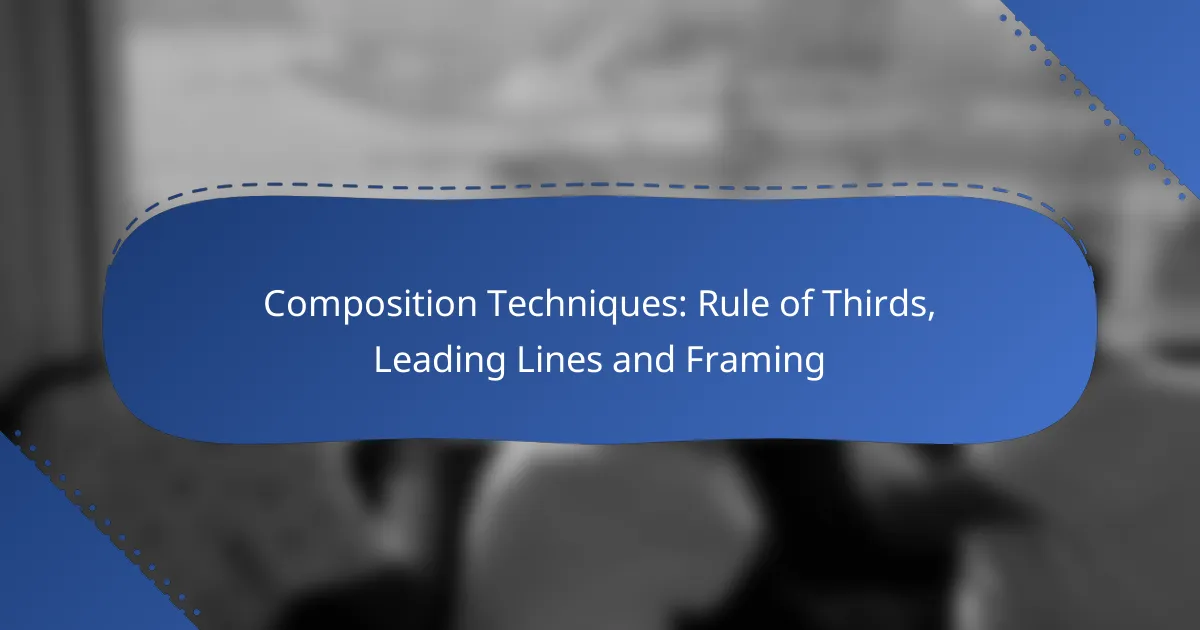Effective composition techniques such as the Rule of Thirds, leading lines, and framing are essential tools for photographers looking to enhance their visuals. The Rule of Thirds divides an image into a grid, helping to position key elements for a more dynamic look. Leading lines direct the viewer’s eye toward the main subject, while framing uses surrounding elements to create a border that draws attention and adds depth to the composition.

How can the Rule of Thirds enhance composition?
The Rule of Thirds enhances composition by dividing an image into nine equal parts, creating a grid that helps position key elements. This technique encourages more dynamic and engaging visuals by guiding the placement of subjects along the grid lines or at their intersections.
Creates balanced images
By applying the Rule of Thirds, photographers can create balanced images that feel harmonious. Placing subjects off-center, rather than in the middle, allows for a more natural distribution of visual weight, making the overall composition more appealing.
For example, when photographing a landscape, positioning the horizon along the top or bottom third of the frame can enhance the sense of depth and space, leading to a more satisfying image.
Guides viewer’s eye
The Rule of Thirds effectively guides the viewer’s eye through the composition. By aligning focal points with the grid lines, you create a visual pathway that draws attention to important elements in the scene.
In practice, if a subject is placed at one of the intersections, the viewer’s gaze is naturally directed towards it, making the image more engaging. This technique is particularly useful in portrait photography, where the subject’s eyes can be aligned with these key points.
Improves visual interest
Utilizing the Rule of Thirds can significantly improve the visual interest of an image. By breaking away from traditional centering, compositions become more dynamic and intriguing, encouraging viewers to explore the entire frame.
To enhance visual interest, consider incorporating leading lines or contrasting elements in the remaining sections of the grid. This can create a sense of movement and depth, making the image more captivating and memorable.

What are effective ways to use Leading Lines?
Leading lines are compositional elements that guide the viewer’s eye towards the main subject of an image. By strategically incorporating these lines, photographers can create more engaging and dynamic visuals.
Directs focus to the subject
Leading lines effectively direct the viewer’s attention to the focal point of the image. For instance, a road or pathway can naturally draw the eye towards a distant mountain or landmark. This technique helps to establish a clear subject, making the photograph more impactful.
To enhance this effect, consider using contrasting colors or textures along the leading lines. This contrast can further emphasize the subject and make it stand out in the composition.
Creates depth in images
Incorporating leading lines can significantly enhance the sense of depth in a photograph. Lines that converge towards a vanishing point create a three-dimensional feel, making the scene more immersive. For example, railway tracks or a row of trees can lead the viewer’s eye into the background, adding layers to the image.
When using leading lines to create depth, ensure that the lines are positioned strategically within the frame. Placing them at an angle rather than straight can enhance the perception of perspective and space.
Enhances storytelling
Leading lines can also contribute to the narrative of a photograph by guiding the viewer through the scene. They can suggest movement or a journey, inviting the audience to explore the image more thoroughly. For example, a winding river can imply a story of adventure or travel.
To maximize storytelling, think about the emotional tone you want to convey. Use leading lines that align with the theme of your image, whether it’s a serene landscape or a bustling urban scene. This alignment can help reinforce the message you wish to communicate through your photography.

How does Framing impact photography?
Framing significantly impacts photography by guiding the viewer’s attention and enhancing the overall composition. It involves using elements within the scene to create a border around the subject, which can lead to more engaging and visually appealing images.
Isolates the subject
Framing effectively isolates the subject by creating a visual barrier that draws attention to it. This can be achieved using natural elements like trees or architectural features such as doorways. By surrounding the subject, the frame minimizes distractions and emphasizes the focal point of the photograph.
For example, photographing a person through an archway can create a strong sense of focus, making the subject stand out against the background. This technique is particularly useful in busy environments where the subject might otherwise get lost among competing elements.
Adds context to images
Framing not only isolates the subject but also adds context to the image, providing viewers with a sense of the environment. By incorporating surrounding elements into the frame, photographers can tell a more complete story about the subject. This context can enhance the emotional impact of the photograph.
For instance, capturing a child playing in a park framed by trees can evoke feelings of joy and freedom, while also situating the viewer in the scene. This approach helps convey the relationship between the subject and its surroundings.
Improves composition structure
Framing improves the structure of a photograph by creating a more balanced and harmonious composition. It helps guide the viewer’s eye through the image, leading them from one element to another in a deliberate manner. This can be particularly effective in landscape photography, where the horizon line can serve as a natural frame.
To achieve a well-structured composition, consider using the rule of thirds in conjunction with framing techniques. Placing the subject at the intersection points while using framing elements can create a visually appealing balance. Avoid cluttering the frame with too many elements, as this can detract from the overall impact of the image.

What are the prerequisites for mastering composition techniques?
To master composition techniques like the rule of thirds, leading lines, and framing, a solid understanding of basic photography principles and familiarity with camera settings is essential. These foundational skills enable photographers to effectively apply compositional strategies to enhance their images.
Understanding basic photography principles
Basic photography principles include concepts such as exposure, lighting, and perspective. Understanding how these elements interact helps photographers create visually compelling images. For instance, knowing how to manipulate light can significantly affect the mood and clarity of a photograph.
Additionally, grasping the rule of thirds can help in framing subjects more dynamically. This technique involves dividing the frame into a 3×3 grid and placing key elements along the lines or at their intersections, which often results in a more balanced and engaging composition.
Familiarity with camera settings
Being familiar with camera settings such as aperture, shutter speed, and ISO is crucial for effective composition. These settings influence how light is captured and can dramatically alter the final image. For example, a wide aperture can create a shallow depth of field, isolating the subject from the background.
Moreover, understanding how to adjust these settings in different lighting conditions allows photographers to maintain control over their compositions. Regular practice with various settings in diverse environments can help develop an intuitive sense of how to achieve desired effects in photographs.

How do these techniques compare in different photography styles?
The Rule of Thirds, Leading Lines, and Framing are composition techniques that vary in effectiveness depending on the photography style. Each technique serves a unique purpose and can enhance the visual storytelling of landscapes, architecture, and portraits.
Rule of Thirds in landscape photography
The Rule of Thirds divides an image into nine equal parts, guiding the placement of key elements along the lines or at their intersections. In landscape photography, this technique helps create balanced compositions by positioning the horizon along the top or bottom third of the frame. For instance, placing a mountain range on the upper third can emphasize the sky, while a foreground element like a tree can anchor the lower third.
When applying this rule, consider the focal points in your landscape. Using the Rule of Thirds can lead to more dynamic images, but avoid overcomplicating the scene. Simplicity often yields the most striking results.
Leading Lines in architectural photography
Leading Lines draw the viewer’s eye towards the main subject, creating depth and perspective. In architectural photography, lines from buildings, pathways, or railings can guide the viewer’s gaze and enhance the structure’s form. For example, a long corridor or staircase can serve as a leading line that directs attention to a focal point, such as a doorway or a significant architectural feature.
To effectively use Leading Lines, look for natural lines in your environment and consider their angles and directions. Ensure that these lines lead to a clear subject to avoid confusion. Experiment with different perspectives to find the most compelling compositions.
Framing in portrait photography
Framing involves using elements within the scene to create a ‘frame’ around the subject, drawing attention and adding context. In portrait photography, this can be achieved with natural elements like trees, windows, or doorways. For instance, positioning a subject within an archway can create a visually appealing frame that enhances the portrait’s focus.
When utilizing Framing, ensure that the framing elements do not distract from the subject. Keep the frame subtle and complementary, and consider the depth of field to maintain clarity on the subject while softening the background. This technique can add layers to your portraits, making them more engaging.
